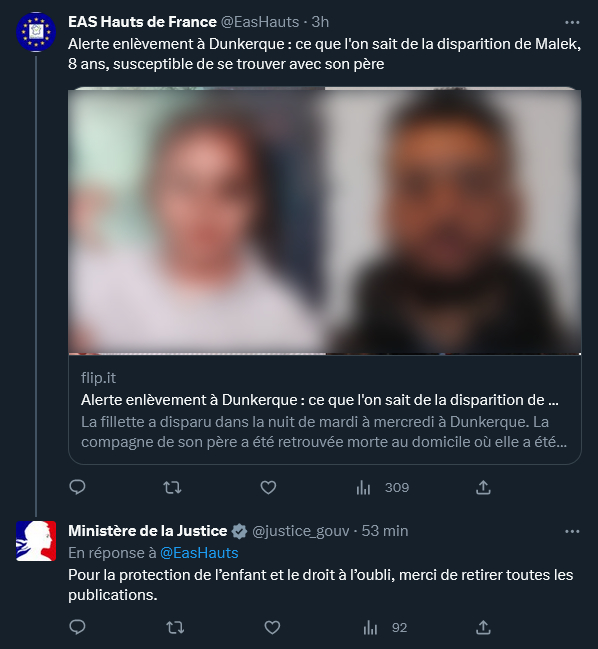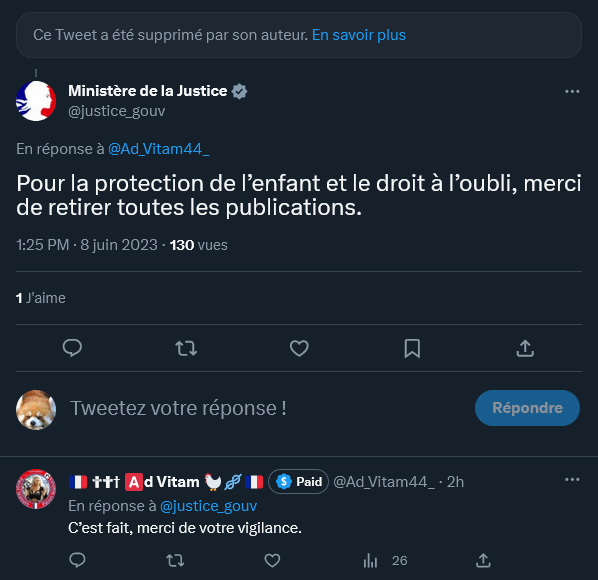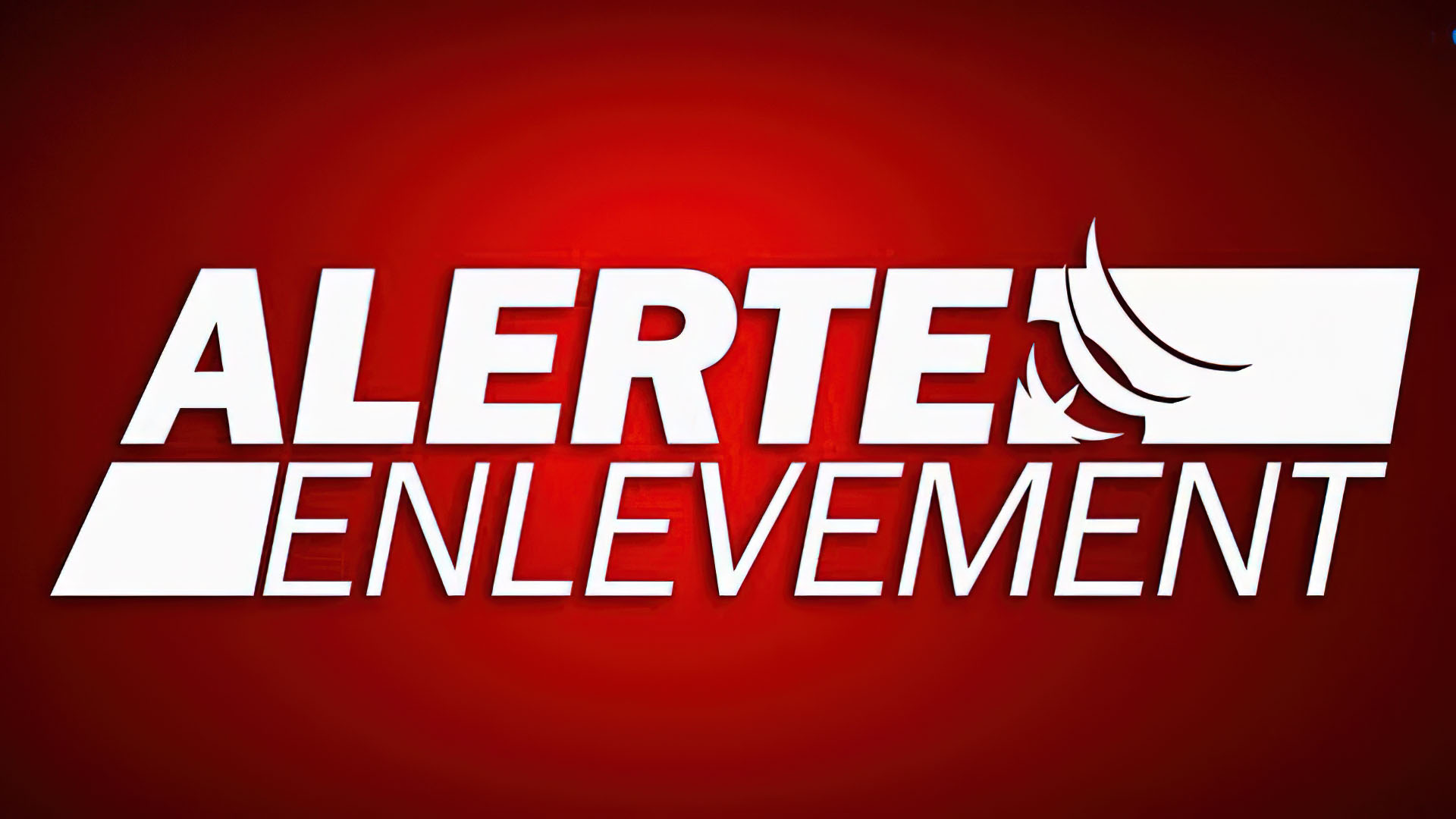The Ministry of Justice is asking users on Twitter who have shared content showing the face of a missing girl. A case that shows the complexity of the relationship between the right to be forgotten and the Abduction Alert on the Internet.
Complex issues sometimes collide head-on. We see this for example with the right to be forgotten, often wedged between the right to information for the public and that for the individual to be able to move on. Arbitration is done on a case-by-case basis, with occasionally no ideal outcome. A new illustration of this difficult balance has just come to light.
The press reported on June 7 the disappearance of an eight-year-old child in the North. She disappeared in Dunkirk overnight from Tuesday to Wednesday. The girl, named Malek, was reportedly kidnapped by her father. The Abduction Alert plan was initiated, before being lifted. The girl has not yet been found. His mother was found dead, possibly killed by her spouse.
In place since 2006, the Abduction Alert system includes various partners to disseminate the report as widely as possible. Television, radio, public transport, highways, billboards, websites, but also certain social networks are involved. And, of course, Internet users also share the alert.
Post-Kidnapping Alert: Photos That Remain Online
This is where the collision between opposing stakes occurs. In the logic of an Abduction Alert, it is a question of giving information making it possible to know what the child looks like and of disseminating it as widely as possible. This increases the chances of finding the minor safe and sound. This of course includes a photo of the victim.
These recommendations can be found in the Abduction Alert agreement: “ on the background, the warning message [….] may include, for example, the following elements: day, time and place of the kidnapping, description of the suspect vehicle, number of its license plate, first name and recent photograph of the victim, photograph of the suspect. »

Yet, as Succession Tristan Mendès France, teacher in the digital field, the Ministry of Justice went against the grain. The institution multiplies the arrests on Twitter to ask Internet users to remove the tweets mentioning the case, when the photo of the girl appears. This, while she has still not been found.
” For the protection of the child and the right to be forgotten, please remove all publications “, we read in the many messages left by the ministry. These Internet users, contacted on the fly by the ministry, often did not upload the photo themselves in the tweet. It is the display mode of the press article that they relay on Twitter that generates the photo.
Twitter, in this case, includes a partial visualization of the links that we share: the insert under the tweet shows the title of the article at the time it was taken up by the social network, a written extract from the article and an illustrative image of the article. In several cases, it is a montage putting side by side the head of the little girl and that of her father.
The request from the Ministry of Justice reflects the lifting of the Abduction Alert: according to the authorities, it is no longer necessary to spread information about the child. However, there is necessarily an inertia between the moment when the decision to stop this diffusion and when the information will be received by everyone – the most recent tweets show it.
” By decision of the Douai public prosecutor’s office, the kidnapping alert is terminated. The child has not been found. Research continues. Photos should no longer be posted », noted the Ministry of Justice, causing misunderstanding among internet users. Some complied with the request, others did not respond immediately.

When the Kidnapping Alert comes to an end, the child’s first immediate interest, that of his survival, is generally achieved (in the vast majority of cases, the end of this system ended in a happy outcome). It is then that another interest is set in motion: that of the right to be forgotten, that is to say the right to peace of mind and no longer to have one’s face everywhere on the net.
A problematic raised also by Vincent Flibustier, lecturer in digital citizenship. ” When you share the alert from an official account, when the alert is lifted, the tweet is taken down by the police/official account. If you made an RT, it will also disappear from your thread. But in other cases, the media will remain. Sometimes a long time.
This is why it is recommended to avoid posting this type of content yourself or relaying unofficial accounts. In the case of press articles, it is more delicate, because the content of the site may have been updated to remove the child’s photo. But the content embedded by the tweet when it was necessary to broadcast his face is not updated.
In this case, the victim is not necessarily helpless: it is possible to make a request to remove the photos (by the parents, a legal guardian or here the authorities). However, it is tedious work, which is not always (quickly) followed by effect. We see it with the action of the ministry, which chained the messages, with more or less success.
Do you want to know everything about the mobility of tomorrow, from electric cars to pedelecs? Subscribe now to our Watt Else newsletter!
